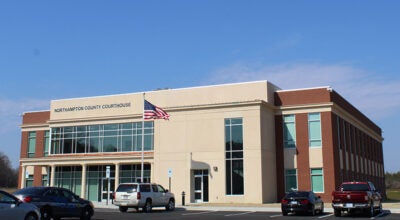Local schools fair well on ABC’s of Education
Published 9:42 am Tuesday, August 7, 2012
The test results are in and the majority of public schools in the Roanoke-Chowan area joined their brethren across the state by meeting or exceeding academic growth goals.
On July 31, the State Board of Education received the 2011-12 ABCs of Public Education report, one that showed nearly 80 percent of North Carolina public schools were on target or were above their goals.
The report also noted that 46.2 percent (1,165 schools) of all schools met all of their Annual Measurable Objectives (AMOs). AMOs have replaced the Adequate Yearly Progress (AYP) measures previously required by the U.S. Department of Education. Under AMOs, proficiency targets are set for each student subgroup. Before AMOs were allowed, there was only one proficiency target for all student subgroups.
“The ABCs model has served North Carolina well by focusing on school-level accountability, and back in the mid-1990s when the ABCs model began this model was considered groundbreaking,” State Superintendent June Atkinson said. “Our new READY accountability model, which will replace the ABCs beginning this school year, will stay focused on individual schools but will more squarely measure career and college readiness.”
The ABCs report showed that 43.9 percent of schools met high academic growth standards and 35.6 percent of schools met expected growth.
Gates County Public Schools led the local area in the ABC’s of Education rankings. Each of the county’s five schools – Buckland Elementary (a Performance Composite score of 77.9%), Central Middle (74.5%), Gates County High School (76.5%), Gatesville Elementary (88.2%) and T.S. Cooper Elementary (81.9%) met expected growth. The high school and Cooper Elementary were listed with high growth. With the exception of Central Middle, the Gates County schools met all AMO targets.
Gatesville Elementary and T.S. Cooper Elementary were listed as Schools of Distinction. Buckland Elementary, Central Middle and Gates County High were named as Schools of Progress.
In comparison to how the rest of the public schools statewide faired on the ABC’s of Education, Gates County ranked 14th of 115 districts.
Gates County Schools Superintendent Dr. Barry Williams praised the district’s teachers for the ABC’s success.
“Our teachers look beyond students’ test scores to their success in life,” Williams said. “Our professional educators have students do the kind of work that will truly prepare them for future success – creative writing, research, oral presentations and persuasive essays.”
In Bertie County, one school (STEM High School) produced a Performance Composite score of 97.4 percent and was listed among those educational facilities receiving the state’s top honor – Honor School of Excellence with High Growth.
Meanwhile, four others in Bertie County were named as Schools of Progress, each with high growth – Bertie Middle (a Performance Composite score of 70.3%), Aulander Elementary (67.5%), West Bertie Elementary (64%) and Colerain Elementary (69.9%).
Bertie High School (48.9% composite score) and Windsor Elementary (55.7%) each met expected growth, but both were listed as Priority Schools.
Bertie Early College, West Bertie Elementary, Colerain Elementary and Bertie STEM met all their AMO targets.
Five of Hertford County’s seven public schools met expected growth – Ahoskie Elementary (a Performance Composite score of 66.2%), Bearfield Primary (63.3%), Hertford County High School (80.4%), Hertford County Early College High School (95.4%) and Riverview Elementary (59.3%). Hertford County High, Early College and C.S. Brown High School (composite score of 94.4%) were listed with high growth. Early College, C.S. Brown and Riverview met all their AMO targets.
With their lofty composite scores, Hertford County Early College was listed as an Honor School of Excellence while Hertford County High School was named as a School of Distinction. Ahoskie Elementary and Bearfield Primary were both named as Schools of Progress.
Hertford County Middle (59.4% composite score) and Riverview Elementary were tabbed as Priority Schools.
“The numbers tell the story better than I can,” said HCPS Superintendent Dr. Michael Perry. “Five of our schools made academic growth and three hit all the AMO targets. That tells me we’re heading in the right direction.”
Perry, who just arrived as the HCPS Superintendent, stressed that these scores are the fruit of many years of nurturing the seed of education.
“I truly believe that by keeping our fundamental and foundational programs in place, there’s no end to what we can accomplish,” he stated. “These are tremendous scores from all our schools this year. These incredible results are due to the hard work put in by our students, teachers and administrators.”
Northampton County also fared extremely well on the ABC’s of Education with seven of its nine schools meeting expected growth – Gaston Elementary (a Performance Composite score of 61.2%), Alternative School (32.8%), NCHS-East (84%), Squire Elementary (no score listed), Willis Hare Elementary (64%), NCHS-West STEM (66.7%) and Gaston College Prep (89.7%). Of that growth, all but NCHS-West STEM met high growth.
NCHS-East and Gaston Prep were both named as Schools of Distinction. Gaston Elementary, Squire Elementary, Willis Hare Elementary and NCHS-West STEM were listed as Schools of Progress.
Conway Middle School (a composite score of 64.3%) received no special recognition. Central Elementary is a Priority School.
A trio of Northampton schools met all AMO targets – the Alternative School, NCHS-East and Gaston Prep.
Northampton Superintendent Dr. Eric Bracy commended Gaston Elementary School for its significant gain of close to six percentage points and NCHS-East for its gain of just over four percentage points in overall performance composite.
Bracy said the two high schools again showed significant progress with the overall composite score. Algebra I proficiency increased from 71.1% to 81.5 and Biology again saw a large gain from 79.6% to 92.9%.
Reading and math results for grades 3-8 did not change from last year; however, the reading proficiency gap between White and African American students in those grades closed by 5.4 percentage points.
Bracy also praised the graduation rate (81.3%) at NCHS-East, boasting an improvement from 78.3% the previous year.
“The work of our teachers, administrators and other staff members to support students is resulting in some gains in academic achievement,” Bracy said. “In addition to being a School of Distinction, Northampton County High School East is the highest performing traditional high school in the Roanoke Valley. With a composite of 84.0 and high growth, this high school is leading the way to excellence. We are especially proud of the three schools that made High Growth and our high schools.”
He continued, “The data also point to the need for a renewed focus on reading at the elementary and middle school levels. As we implement the rigorous new Common Core standards in the coming year, it is imperative for our students to be able to read well. Parents and the entire community can help support our literacy efforts by encouraging students to read.”
The ABCs report is based on several measures of performance. These include reading and mathematics end-of-grade tests in grades three through eight; science tests in grades five and eight; and end-of-course tests in English I, Algebra I and Biology. Other measures include the cohort graduation rate and student performance on alternate assessments for certain students with disabilities.
This is the 16th and final year of the ABCs program. For the fourth consecutive year, the state’s budget did not include funding for the ABCs incentive awards for qualifying educators whose schools met or exceeded its growth goals. These awards were an integral part of the program until 2009.
Beginning with the 2012-13 school year, North Carolina public schools will operate under the new READY accountability model with first-year results reported in fall 2013. Also beginning with the 2012-13 school year, all public school teachers will be using the state’s new Standard Course of Study, which includes Common Core State Standards for English language arts and mathematics. The state’s assessment program will include formative assessments along with end-of-grade and end-of-course assessments. Teachers will use the formative assessments to ensure students are grasping the concepts being taught in the classroom. These assessments, which are not graded or part of the state’s accountability program, are more of a pulse check on student proficiency.
For more information on the READY initiative, please visit www.ncpublicschools.org/ready.




